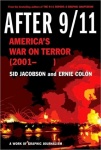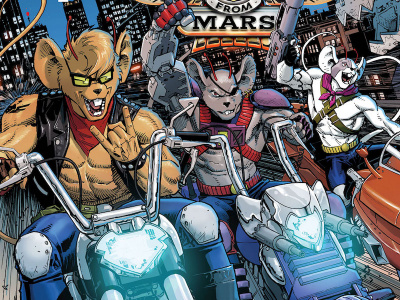
After 9/11:
(Hill and Wang) August 2008 160 pages
Sid Jacobson & Ernie Colón
ISBN (Hbk) 978-0-8090-2357-8 $30.00
ISBN (Pbk) 978-0-8090-2370-7 $16.95
ICv2 Stars: 2 (out of 5)
Jacobson and Colón, the creative forces behind The 9/11 Report: A Graphic Adaptation, decided to combine their talents again in a book that purports to look at what
The biggest failing is that they have thrown off the distanced observer tone that made The 9/11 Report seem impartial in favor of an almost editorial feel. The writing is deadly dull, filling each page with small clusters of text, almost all of which begin with a date followed by the events that happened. Since those dates are rarely followed by a year, though, the timeline is increasingly hard to follow. Historical events that have no bearing on the subject matter, such as the deaths of former Presidents Reagan and Ford or the destruction caused by Hurricanes Charley and Katrina, are included for no apparent reason. The book included no source notes for the data, statistics, quotes, timelines, or any other details, which leaves it wide open to factual challenges.
The art, which was clear and realistic, obviously drawn but never cartoonish in The 9/11 Report, verges close to political cartoon-like caricatures in many cases in this work. On top of that, the layout is poorly done and awkward to follow. Each page is crowded with text, but the small paragraphs often move about in odd, counter-intuitive directions, making it tricky to read down the page. Many text blocks overlap pictures that are not related to the point of the text. Other pictures are unidentified, leaving the reader to guess about their subject matter. More concerning are the photographs that have been digitally altered to look like drawings or paintings, with no notes telling who the original photographer was.
In their afterord, the creators say, “It is important…that we tell this story as plainly as possible. It is too important that we all understand exactly what has taken place these last six years. We hope that we have succeeded.” Unfortunately, they did not. Their book is an important attempt to tell the story of a long, deadly, and costly war, but in their attempt they both add too much and include too little, they don’t clarify enough, and they ultimately fail to make best use of the visual medium of their storytelling device.
-Snow Wildsmith
Librarian for the Mountain Island Branch of the Public Library of Charlotte and Mecklenberg County in North Carolina and a regular reviewer for ICv2.







